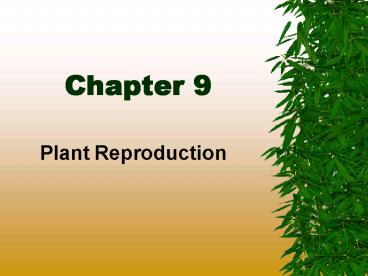Plant Reproduction PowerPoint PPT Presentation
1 / 25
Title: Plant Reproduction
1
Chapter 9
- Plant Reproduction
2
Section 1
- Introduction to Plant Reproduction
3
Types of Reproduction
- Asexual plant reproduction-when plants reproduce
from other plant cells, identical to parent. - Example- when a leaf sprouts into a new plant.
4
Sexual Reproduction
- Sexual plant reproduction-when a sperm and egg
cell combine to form a seed for a new plant. - Example-when a bee takes pollen to a flower an
seeds form.
5
Reproductive organs
- Plants can have male and female reproductive
organs on same plant or separate plants. - Example- holly plants have male and female
plants. - Pea plants have male and female on same plant.
6
Plant Life Cycles
- 1.)Gametophyte stage-when cells in reproductive
organs undergo meiosis and produce haploid cells
called spores. - 2.)Sporophyte stage-when fertilization occurs by
the joining of haploid sex cells. Cells have
diploid number of chromosomes.
7
Section 2
- Seedless Reproduction
8
Spores
- Spores-haploid cells produced during gametophyte
stage, divide by mitosis and form plants that
will produce sex cells.
9
Nonvascular Seedless Plants
- Moss is a nonvascular seedless plant-water moves
from cell to cell.
10
Moss Life Cycle
- Gametophyte stage-green low growing mass of
plants. - Sporophyte stage-brown stalks grow up from green
plant capsule on end of stalk has millions of
spores which are released when conditions are
right. - Can produce asexually if small piece of plant
breaks off and falls into moist soil.
11
Vascular Seedless Plants
- Vascular Plants-use vascular tissue to transport
water from roots to plant. - A Fern is a vascular plant.
12
Fern Life Cycle
- Frond-fern leaf
- Rhizome-underground fern stem
- Sori-structures that produce fern spores
- Prothallus-small heart shaped gametophyte
- Picture of new frond opening
13
Fern Life Cycle
- Sporophyte stage-plants have fronds, rhizome,
produce food by photosynthesis. They have sori
that produce spores
14
Fern Life Cycle
- Gametophyte stage- grows from spore into
prothallus. - Ferns can also reproduce asexually- a branch can
be taken off and planted to make a new plant.
15
Section 3
- Seed Reproduction
16
Seed Reproduction
- Pollien-spores turn into pollen in seed plants.
- Pollen grain-has water resistant covering and
contains gametophyte parts that produce sperm. - Pollination-transfer of pollen to female part of
plant
17
Seeds
- 3 parts-seed coat, stored food, and embryo
- Gymnosperms-seeds produce in cones
- Angiosperms- seeds produce in flowers
18
Gymnosperm Reproduction
- Male cones produce pollen
- Female cones contain ovules that contain eggs
- Then pinecones open to reveal seeds.
19
Angiosperm Reproduction
- Use flowers to reproduce
- 4parts of a flower
- Petals
- Sepals-small leaf outside of petals
- Stamen-male reproductive organ
- Pistil-female reproductive organ with the swollen
base called ovary
20
Importance of flowers
- Large flowers with bright petals attract insects
and other animals to spread pollen. - Flowers with small petals and drab color use
wind, rain and gravity to spread pollen. - Flowers that open at night are yellow or white
and have strong odor to attract animals.
21
Angiosperm Seeds
- Pollen lands on stigma.
- Pollen tube grows down through style to ovary and
ovule. - The sperm travels down the pollen tube and
fertilizes ovule. - A zygote forms and grows into plant embryo.
22
Seed Development
- Ovule develops into the stored food and seed coat
around embryo. - Stored as cotyledons in peanuts.
- Stored as endosperm in corn.
23
Seed Dispersal
- Wind
- Gravity
- Water
- Animals-when eaten and passed through digestive
tract. - Animals-carried on fur.
24
Seed Germination
- Seeds germinate when environmental conditions are
right. - The seed first absorbs water to burst seed coat
and begin germination. - Then chemical reactions occur to release energy
from stored food. - Then it takes root and the stem and leaves grow.
25
The End

